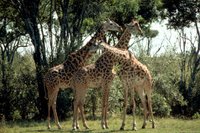 | Title: Masai giraffe, Alternative Title: (Giraffa camelopardalis tippelskirchi), Creator: Stolz, Gary M. Source: WO5635-007, Publisher: U.S. Fish and Wildlife Service, Contributor: DIVISION OF PUBLIC AFFAIRS. |
File size: 312 KB, Format: JPEG image (image/jpeg), Dimensions: Screen: 1083px x 722px, Print: 7.22 x 4.81 inches, Resolution: 150 dpi (mid, presentation quality), Depth: Full Color.
Unless otherwise indicated, resources in the Digital Library System are in the public domain. No restrictions or copyrights are placed upon these materials. You may credit the source of the resource using the information contained in the "Creator" or "Rights" field of the resource record.
Generally speaking, works created by U.S. Government employees are not eligible for copyright protection in the United States. See Circular 1 "COPYRIGHT BASICS" from the U.S. Copyright Office.
Anyone incorporating a work of the U.S. Government into a copyrighted work should be aware of 17 U.S.C. § 403. This section requires a copyright notice to contain a statement identifying what portions of the work consist of a work of the U.S.Government.
There is only one species of giraffe, with nine currently recognized subspecies. The different subspecies can be recognized by their patterns and also by where they live in Africa. Masai giraffes Giraffa camelopardalis tippelskirchi, from Kenya, have patterns that look like oak leaves. San Diego Zoo's Animal Bytes: Giraffe.
“While Masai giraffes are not threatened or endangered in their native habitat, there are only 63 of them in North American zoos,” Houston Zoo Announces Birth of Masai Giraffe.
RELATED: Giraffe (Giraffa camelopardalis) - Giraffe/Giraffa comes from the Arabic word "zarafah", which means "one who walks swiftly" (Gotch, 1995). Camelopardalis = camel (camelus), leopard (pardus); Latin. Centuries ago, it was thought that giraffes were part camel and part leopard.













No comments:
Post a Comment